
Simplisafe is currently running one of the best promotions we've seen. Check their website for full details.
What is Video Doorbell Pro?
Simplisafe's Video Doorbell Pro is a video doorbell made by SimpliSafe, the home security company known for low-cost hardware and services.
While SimpliSafe sells an indoor camera, the Video Doorbell Pro is their first camera aimed at protecting your home from the outside in.
The Video Doorbell Pro sells for $169.00. We got ours from Best Buy, and it shipped with a wedge (not a left and right wedge) and three faceplates (black/obsidian, white/cloud, jade/seafoam). The faceplates reportedly only ship with doorbells purchased from Best Buy. If you purchase from SimpliSafe, the doorbell will ship with the white faceplate.
While the doorbell can certainly work with a SimpliSafe Home Security System (either the original or new), a security system is not a requirement. The doorbell can also be used as a standalone doorbell. We tested it with and without a SimpliSafe system and we will discuss both options below, but for now, let’s talk installation.
If you're considering the Simplisafe doorbell, we encourage you to check back at the Simplisafe website as they have been known to run specials to include cameras.
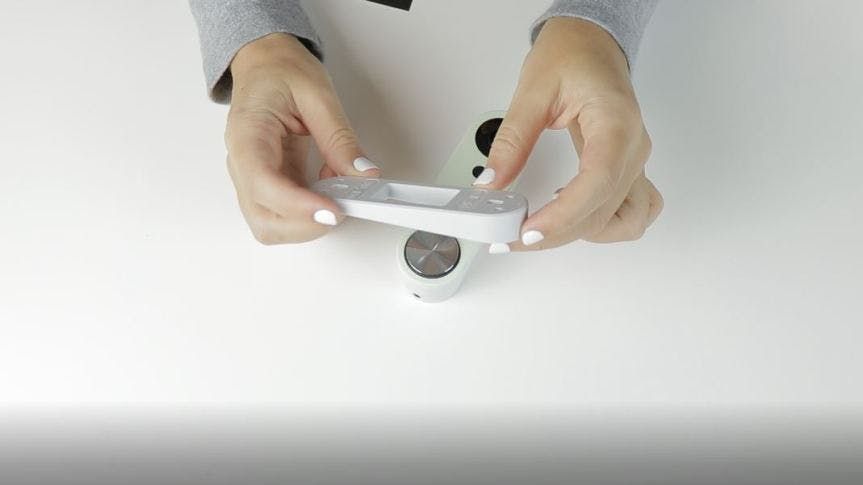
Installing SimpliSafe Video Doorbell
We're not going to dig into the details of installation as there’s nothing unusual about the process. Most people can probably install the doorbell in about thirty minutes, but there are some things you need to know before you buy and there are a couple of issues you might run into after you buy.
First, Video Doorbell Pro is a wired doorbell. It requires an existing doorbell (8-24VAC), an analog (mechanical) door chime, and a 2.4Ghz network connection. As far as tools, they say that most should be able to get it done with a Phillips head screwdriver. You will also need a power drill if you are installing on stone, brick, or stucco.
In the box, you will find your doorbell, three faceplates (assuming you ordered from Best Buy), an angled base, mini screwdriver, and screws. The actual installation process consists of nine steps:
- Turn off the power to your doorbell at the circuit breaker.
- Remove your existing doorbell.
- Thread the doorbell wires through the center of the mounting bracket. (If you are installing in a corner or on an angled base, use the wedge.)
- Screw the mounting bracket to the wall.
- Connect wires to the mounting bracket.
- Slide your doorbell into place.
- Turn power back on.
- Press the doorbell to test the chime connection.
- Optional: Install the lock screw at the button of the doorbell to secure it in place.
It was at step eight that we ran into the first issue. Apparently, if you press the doorbell and don’t hear a chime, you just need to be patient. Though the doorbell is wired, it does have a small battery. The battery may need several minutes to charge before the doorbell will work.
After giving our doorbell a few minutes, it worked great, but it’s here that several other users have run into installation challenge number two.
We can break challenge two into two parts:
- Digital Doorbells
- Continuous Chiming
If you have a digital doorbell, you’re out of luck. SimpliSafe does not support digital doorbells.
Many users have also reported issues with continuous chiming.1 This problem may be resolved by buying a doorbell chime connector. You can call SimpliSafe and ask for one, but according to one source, they are sold out. We ended up leaving the chime connector we used when we tested Nest Hello and it worked just fine.
Camera Hardware and Video Quality
From a hardware perspective, SimpliSafe has done a lot of things right. The doorbell offers a FHD 1080p resolution (not adjustable, but will auto adjust for bandwidth) and HDR, which was noticeable from the moment we plugged the doorbell in. For example, below you will find a screenshot taken from a clip from the original Ring Video Doorbell. While newer Rings offer HDR, the original does not. As you can see, the contrast between the shade and the light beyond causes a washout. The homes across the street are not visible using Ring.
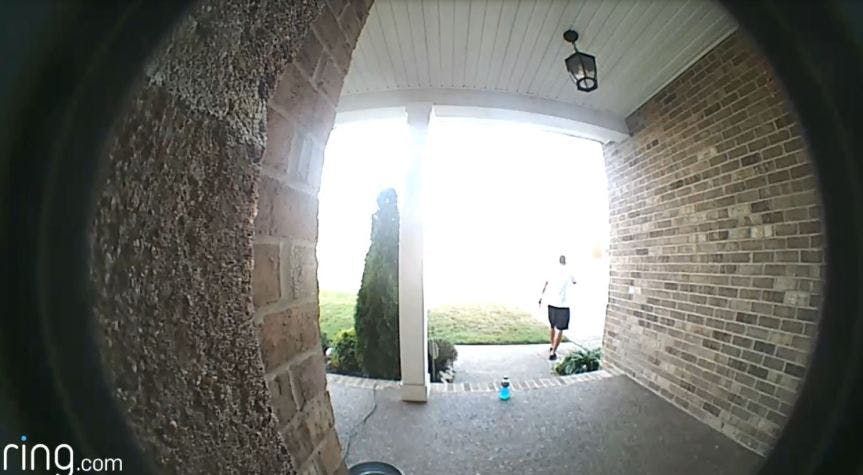
By contrast, here’s a shot from the SimpliSafe Doorbell where the homes across the street are visible.
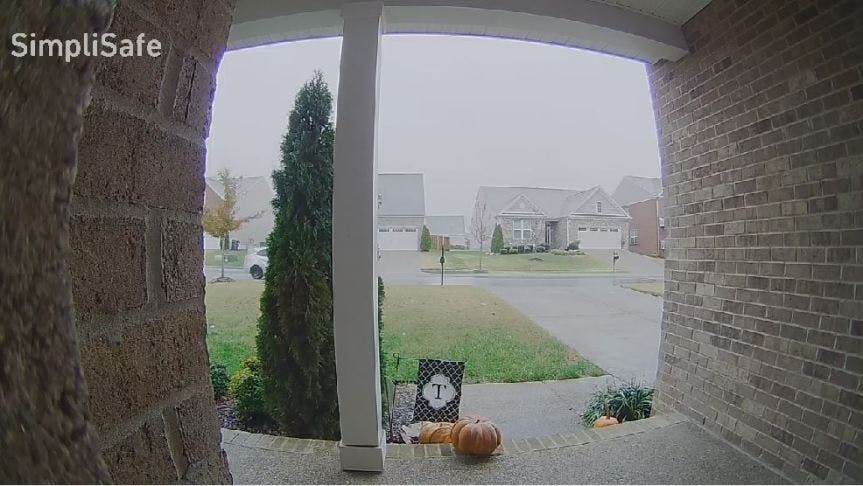
You might also notice that SimpliSafe has less of a fisheye effect, and yet, offers a decent angle. The Video Doorbell Pro has a 162° field of view. Regarding daytime video performance, it’s nearly identical to Nest Hello. To compare, we’ve included a screenshot from Nest Hello below.
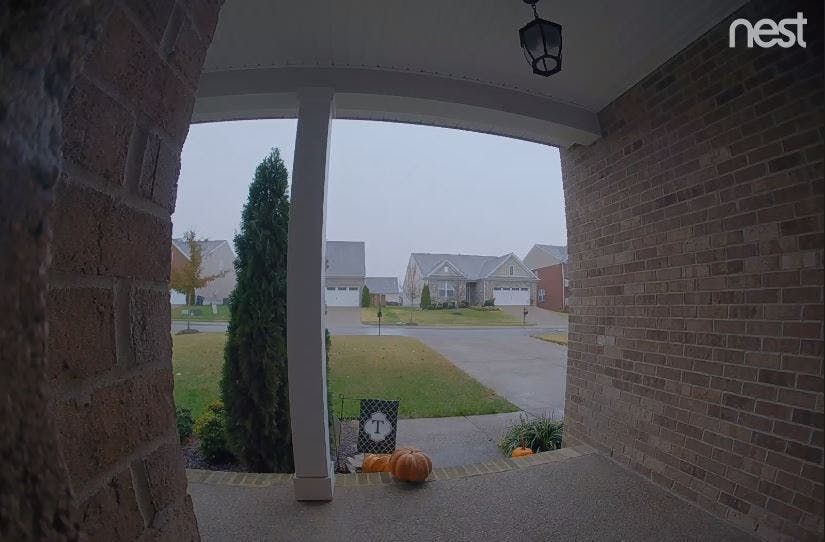
Nest Hello has a different aspect ratio than SimpliSafe, allowing for a taller photo. Overall, Nest’s coloring is less blasted, but SimpliSafe gives a solid performance during the day. Of course, it also has night vision.
At night, video quality faltered. The picture was washed out and visibility did not reach far. As you can see below, you can no longer see the homes across the street.
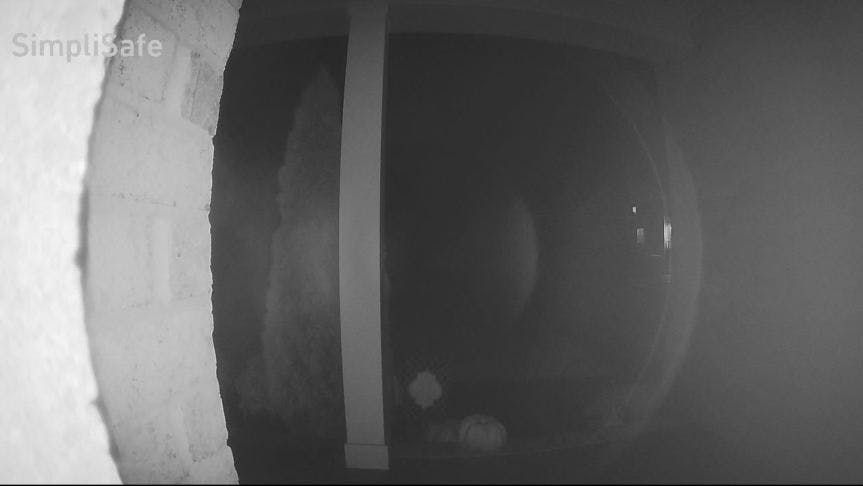
To compare, here’s a shot from Nest Hello.
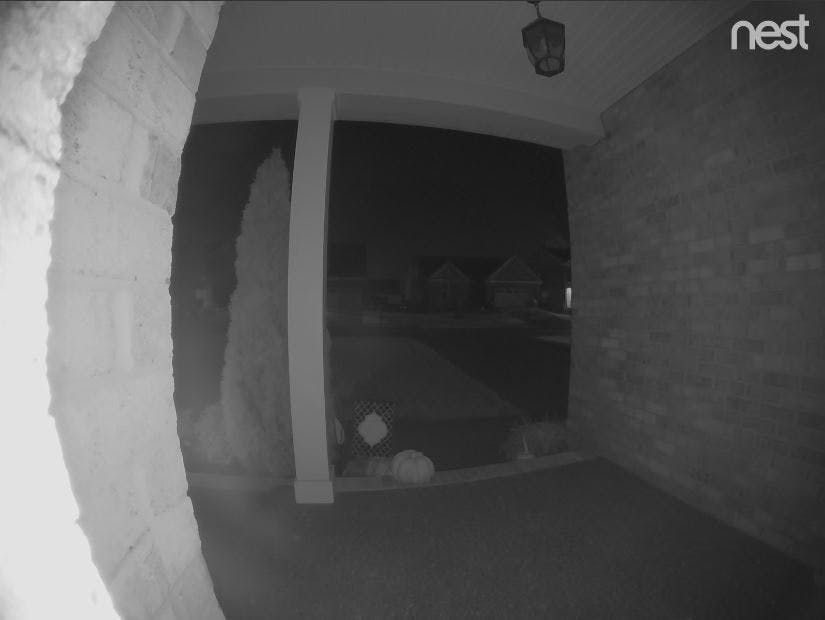
SimpliSafe also lacks a low-light sensor, which meant that it swapped to black and white night vision well before most of our other outdoor cameras.
Regarding hardware, SimpliSafe Video Doorbell Pro also offers:
- Two-Way Audio
- Motion Alerts
- Digital Pan and Zoom
- Connection to Doorbell Chimes
- 14° to 104°F Operating Temperature
Home Security Features
Live streaming, two-way audio, ring alerts, and motion detection are the only security features offered by this doorbell.
Live Streaming and Two-Way Audio
We’ve already discussed video resolution which ties into live streaming, but there are related features we should review. First, they claim that you can digitally pan and zoom, but this feature only works if you are using a horizontal view.
Second, there was a lag of about two seconds between what's on the screen and what was happening in real life. Keep in mind that this lag impacts both the visual aspect of the video and the audio which makes using two-way audio a little awkward.
SimpliSafe’s two-way audio feature is walkie-talkie style. You press the button to talk and then release the button to listen. Remember to be patient throughout this process as there is a lag.
Finally, two-way audio events were not automatically recorded. Most two-way audio events will be triggered by motion, but our camera missed a couple. To ensure that the event is recorded, you can hit the manual record button before initiating two-way audio. That said, the camera will not record your voice, only the voice of the person you are talking to. While it’s a two-way conversation, only one side is recorded.
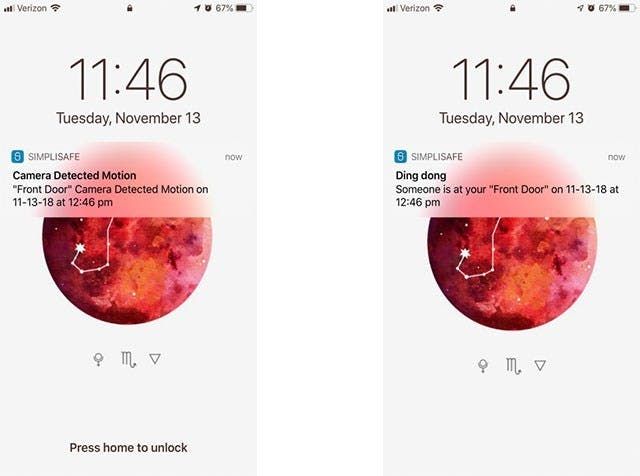
Ring and Motion Alerts
Video Doorbell Pro will alert via push notification if it senses motion or if someone rings the doorbell. Push notifications for motion events will indicate motion and ring alerts will say, “Someone is at your “Camera Name” followed by the date and time.
We found the alert speed to be reasonably fast, usually within 2-3 seconds of someone ringing the bell or walking by, but there were two problems.
First, there is a built-in re-trigger time (not adjustable) on motion alerts. If your camera senses motion, it will not notify you again for five minutes.
Second, we had a lot of trouble getting push notifications to work. We had to delete and re-download the app twice. Each time push notifications would work for a bit and then stop. What solved the issue was deleting the doorbell from the account and re-installing it.
As far as false alarms, they were non-existent during testing when using the medium setting and rare when using the high setting. (From the mobile app, you can adjust the motion detector’s sensitivity level from low to medium to high.) But we know from reading the forums that this hasn’t been the case for everyone. Perhaps this is because we placed it pretty far from the street? Perhaps it’s PIR?
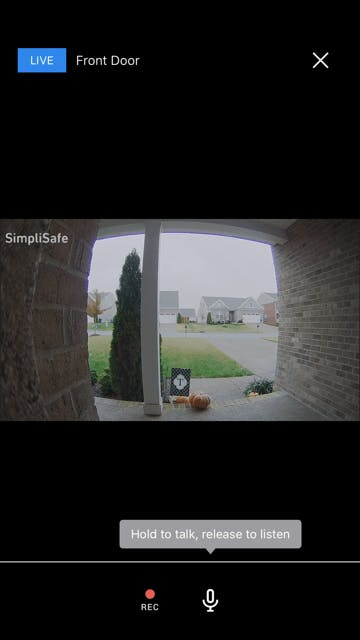
The Video Doorbell uses a PIR motion sensor which helps reduce false alarms. A PIR sensor allows the camera to detect heat in addition to movement, which means that it should ignore cars passing by and trees swaying but should alert you if a person walks by. As mentioned above, this was mostly true, though we definitely got a few videos of cars passing by. On SimpliSafe’s website, it also says that the camera “detects human form,” but this is a feature they have yet to roll out. At this time, all the doorbell has is a PIR motion sensor.
If motion alerts don’t work out for you, you can turn motion detection off and rely solely on ring alerts. Or you can leave motion detection on and turn off motion notifications.
You can also turn doorbell ring notifications on and off, and you can turn night vision on and off or leave it set to auto (the default). Finally, the camera has a small status light that displays when your camera is streaming or recording. If you prefer, you can also turn this off. As far as customization, that’s it.
Using Video Doorbell Pro With and Without SimpliSafe Security
| Alone | With Security System | |
|---|---|---|
| Price | $169.00 | $169.00 |
| Works With | Alone, SS1, SS2, SS3 | Alone, SS1, SS2, SS3 |
| Motion Triggers | PIR Motion Sensor, On-Demand, Human Recognition Coming Soon | Sensor Triggered, PIR Motion Sensor, On-Demand, Human Recognition Coming Soon |
| Live Streaming | ||
| SMS/Email Alerts | Push Alerts Only | Push Alerts Only |
| Cloud Recording Cost | $4.99/month/camera or $9.99/month/unlimited cameras | Standard: $4.99/month/camera or $9.99/month/unlimited cameras | Interactive: Included |
| 24/7 Professional Monitoring | ||
| Video Verification | Interactive Only | |
| Third-Party Integrations | ||
| button company="simplisafe" to="https://simplisafe.com"]Buy Here[/button] | ||
As already mentioned, you can use SimpliSafe’s Video Doorbell Pro as a standalone video doorbell, or you can use it with a SimpliSafe system. Spoiler Alert: There isn’t a huge difference here. We can break down the differences into three categories: cloud storage, video verification, and sensor triggering.
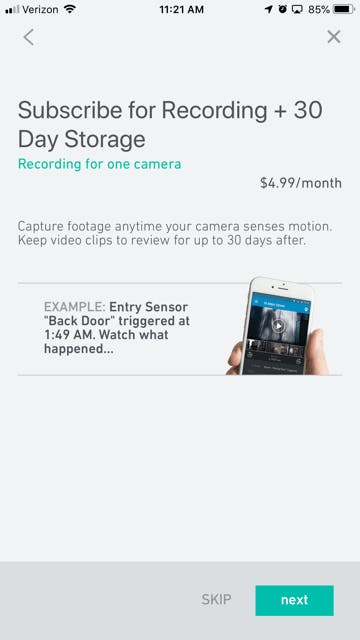
Cloud Video Recording and Video Verification
Using the doorbell is a bit confusing when you compare plans versus standalone use, and this ties into cloud video recording.
For free, you can live stream footage from your doorbell. That’s it. If you want cloud storage, you will need to pay for a recording plan.
If using the doorbell without security monitoring, cloud storage is $4.99 per month for one camera or $9.99 per month for unlimited cameras, which adds 30 days of storage.
SimpliSafe also has two monitoring plans: Standard and Interactive. Standard is $14.99 per month but requires the same plan mentioned above to do anything beyond live stream.
Interactive is $24.99 per month. It includes live streaming and a recorded video history for up to ten cameras. It also includes visual verification which allows SimpliSafe’s monitoring center to access your camera’s recording during an alarm event.
SimpliSafe will hold motion triggered, ring triggered, and on-demand recordings which are viewable from the camera’s timeline.
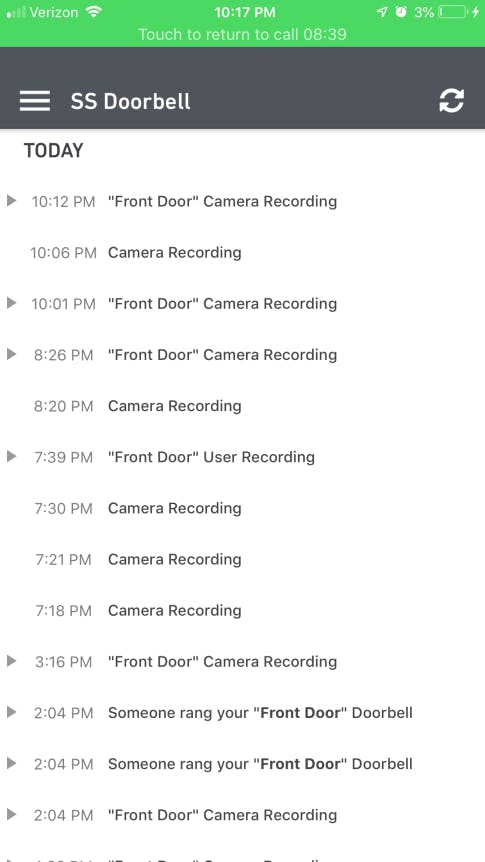
If you click on an event, it will expand and display a short video clip. If it looks like something you want to explore further, you can click on the clip to view it in its entirety. All clips are a minute in length plus 3-4 seconds of pre-roll video. In addition to viewing clips, you can download them. Unfortunately, there is no way to delete clips.
SimpliSafe also has a web app. The web app mimics the features found on the mobile app less some. For one, you cannot adjust the camera’s settings form the web app. Two, you cannot use two-way audio.
There is one gotcha which might affect certain users. During testing, we decided to test SimpliCam (SimpliSafe’s indoor camera) with Video Doorbell Pro. we noticed that if you turn the indoor camera’s privacy shutter on, Doorbell Pro would stop recording. In the screenshot below you can see several events marked as “camera recording.” These events are not playable but indicate motion triggered activity during testing. In essence, the security setting of your indoor camera can affect your doorbell. This is an oversight in my opinion.
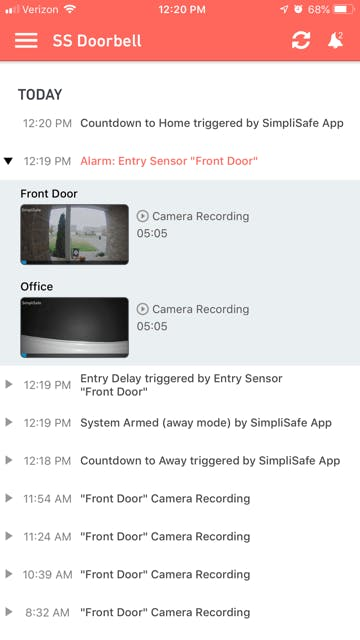
After testing the privacy shutter/doorbell relationship several times, we called into SimpliSafe with the results. After a long while on the phone with them, we finally had a manager confirm that this is indeed true. The workaround is to move your indoor camera to a different location than your doorbell, but if you want to tie the cameras to your home security system, you will have to accept this issue.
Sensor Triggering
Finally, as a standalone camera, Video Doorbell Pro can detect motion and ring events, but when tied to a SimpliSafe Security System, your security sensors can also trigger the camera to record. According to our SimpliSafe contact,
“Its integration with the SimpliSafe home security system is the first of its kind—whenever any SimpliSafe sensor detects activity, the camera captures video (including pre-roll video from before the sensor was triggered) giving users an immediate record of what happened before, during and after the alert.”
We paid for an Interactive Plan to test, hoping that this would add other features like SMS and email alerts or perhaps voice control through Google Assistant and Alexa, but it did not. These features only work with the security system, not the doorbell.
Finally, we armed the system and triggered an event. We had a countdown delay set, and both cameras recorded six times in total.
- 50 Seconds Countdown to Away (exit delay set to 45 seconds)
- 1:20 System Armed Away
- 50 Seconds Entry Delay (after I opened a door)
- 5:05 Alarm
- 50 Seconds Countdown to Home (entry delay set to 10 seconds)
- 25 Seconds System Armed Home
In short, they record more during a sensor triggered event than they do when triggered by motion.

Simplisafe is currently running one of the best promotions we've seen. Check their website for full details.
Final Thoughts
If you don’t currently or have never owned a video doorbell and have zero expectations as to how one might behave, you’re probably going to be excited by SimpliSafe’s option. It’s a step up from an analog doorbell. However, if you have more experience with video doorbells, it will likely feel like a step back.
For one,with SimpliSafe, the doorbell itself makes a sound, and your current chime will sound, but that’s it. You can’t even use your SimpliSafe base station as a chime, which is a shame.
Second, there are no standard replies. With Nest Hello, you can reply using pre-recorded messages like, “You can leave it.”
Third, there’s currently no way to improve the intelligence of motion alerts. SimpliSafe lacks motion zones, person recognition, and person detection (though human form detection is coming soon), all things offered by Nest Hello.
Fourth, it lacks geofencing, which is a feature that turns the doorbell on and off as you come and go. In fact, there’s no way to turn the doorbell off at all.
Fifth, Nest Hello with Nest Aware (starting at $5.00 per month) records continuously. SimpliSafe doesn't have this option.
Finally, and most notably, it lacks rich notifications. With Nest Hello, it sends an alert with a clip of the event. You can press and hold to view it and respond to the alert from your lock screen. With SimpliSafe, you have to swipe to open the alert or navigate back to your timeline to view what’s happening.
However, if you’re a SimpliSafe Security System user and sensor-triggered recording is important to you, this is your only option. Also, keep in mind that Nest Hello sells for $229.00 which is $60 more than SimpliSafe’s doorbell.
FAQs
How long does the battery last?
In testing, it lasted about 2 hours. You will also receive a low battery notification when the battery life falls below 30%.

